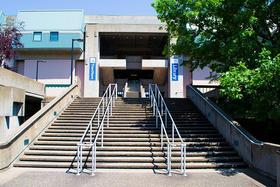- Zane State College is a public community college in Zanesville and Cambridge, Ohio. It was established in 1969 as Muskingum Area Technical College. It offers over 40 associate degree programs and certificates, workshops, and occupational skills training.
School Highlights
Zane State College serves 2,028 students (28% of students are full-time).
The college's student-teacher ratio of 15:1 is lower than the state community college average of 22:1.
Minority enrollment is 13% of the student body (majority Black and Hispanic), which is less than the state average of 38%.
Quick Facts (2025-26)
- Enrollment: 2,028 students
- In-state tuition: $4,646
- Out-state tuition: $9,206
- Student-teacher ratio: 15:1
- Minority enrollment: 13%
- Source: Integrated Postsecondary Education Data System (IPEDS)
Top Rankings
Zane State College ranks among the top 20% of public schools in Ohio for:
Category
Attribute
Debt For Students
School Overview
The teacher population of 132 teachers has stayed relatively flat over five years.
Zane State College
(OH) Community College Avg.
Carnegie Classification
Associate's Colleges: Mixed Transfer/Career & Technical-High Nontraditional
Baccalaureate/Associate's Colleges: Mixed Baccalaureate/Associate's
Institution Level
Four or more years
At least 2 but less than 4 years
Institution Control
Public
Private not-for-profit
Total Faculty
132 staff
93 staff
Student Body
The student population of Zane State College has declined by 10% over five years.
The student-teacher ratio of 15:1 has decreased from 17:1 over five years.
The Zane State College diversity score of 0.24 is less than the state average of 0.58. The school's diversity has declined by 5% over five years.
Total Enrollment
2,028 students
757 students
Student-Teacher Ratio
15:1
22:1
# Full-Time Students
572 students
397 students
# Part-Time Students
1,456 students
360 students
# Enrollment Undergraduate
202 students
313 students
# Full-Time Undergraduate Students
572 students
385 students
# Full-Time Graduate Students
n/a
10 students
# Part-Time Undergraduate Students
1,456 students
434 students
# Part-Time Graduate Students
n/a
3 students
Total Dormitory Capacity
n/a
425 students
% American Indian/Alaskan
n/a
n/a
% Asian
1%
4%
% Hispanic
2%
6%
% Black
2%
15%
% White
87%
62%
% Hawaiian
n/a
2%
% Two or more races
3%
4%
% Non Resident races
n/a
1%
% Unknown races
5%
6%
Diversity Score
0.24
0.58
College Completion Rate (Students who graduate in less than 4 years)
1%
54%
College Completion Rate (Students who graduate in 4 years or more than 4 years)
54%
22%
Average Graduate Earnings (10 Years)
$28,600
$31,900
Tuition and Acceptance Rate
The public in-state tuition of $4,646 is less than the state average of $5,163. The in-state tuition has declined by 14% over four years.
The public out-state tuition of $9,206 is less than the state average of $10,843. The out-state tuition has declined by 13% over four years.
In-State Tuition Fees
$4,646
$5,163
Out-State Tuition Fees
$9,206
$10,843
Tuition Notes
$199 per credit hour for residents of Ohio and $391 per credit hour for out-of-state and international students.
% Students Receiving Some Financial Aid
69%
88%
Median Debt for Graduates
$7,337
$18,500
Median Debt for Dropouts
$3,004
$6,500
Acceptance Rate
n/a
73%
SAT Reading
n/a
460
SAT Math
n/a
475
SAT Writing
n/a
465
ACT Composite
n/a
21
ACT English
n/a
20
ACT Math
n/a
20
Source: 2024 (or latest year available) Integrated Postsecondary Education Data System (IPEDS)
Frequently Asked Questions
How much does Zane State College cost?
Zane State College's tuition is approximately $4,646 for In-State students and $9,206 for Out-State students.
What is Zane State College's ranking?
Zane State College ranks among the top 20% of community college in Ohio for: Least debt for graduating students.
Recent Articles

How to Transfer from Community College to a Four-Year University in 2025
A step-by-step guide for community college students transferring to a four-year university in 2025 — updated strategies, data and expert insights.

Scholarships for Community College Students 2025
Explore updated scholarship programs, tuition data, and expert strategies for community college students in 2025.

The Rise of Technical and Vocational Training in 2025
Explore the 2025 surge in technical and vocational training—enrollment, policy, costs, and why this path is gaining ground for students and parents.









